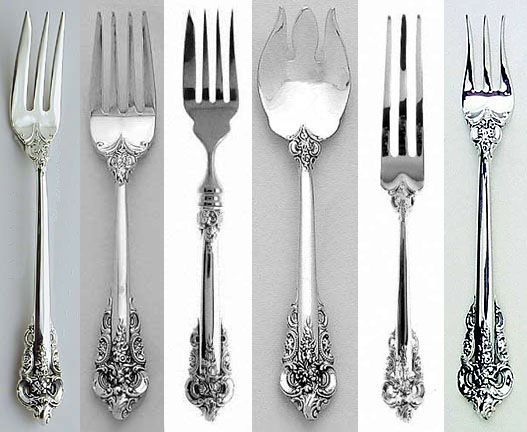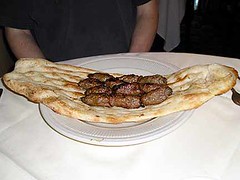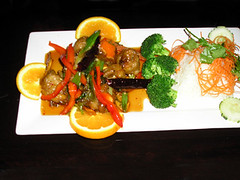 Perhaps, in this day and age of legal review and risk analysis of everything businesses do, restaurants have decided to minimize their customers' access to forks. Given the cost of restaurant checks these days, that might be a prudent decision. Or, perhaps in an even more sinister development, the blacklisting of the fork could be part of the insidious plan of conservative Christianity to dictate morality in even more facets of our lives. After all, when forks first began to be popular in Italy and began to move into France at the end of the 16th century, many leaders of the Church condemned forks as an insult to God, as He had already provided us with fingers to serve as our natural forks.
Perhaps, in this day and age of legal review and risk analysis of everything businesses do, restaurants have decided to minimize their customers' access to forks. Given the cost of restaurant checks these days, that might be a prudent decision. Or, perhaps in an even more sinister development, the blacklisting of the fork could be part of the insidious plan of conservative Christianity to dictate morality in even more facets of our lives. After all, when forks first began to be popular in Italy and began to move into France at the end of the 16th century, many leaders of the Church condemned forks as an insult to God, as He had already provided us with fingers to serve as our natural forks.One of my friends argues with me over issues of what constitutes "proper" English when I despair of use of the language on television and in students' papers, and he says that common usage and common pronunciation makes English "proper." He extrapolates that argument to the flatware scenario and says that rules of etiquette change with usage patterns and the evolution of the lower classes into the targets of marketers and advertisers, thus making the habits of people who don't know any better the new standard of etiquette.
I don't think, though, that the current conspiracy is a matter of evolution. I think it's an economic decision being made by restaurants—restaurants that are trying to force their penny-pinching ways onto American society as though it were proper. These are the same people, after all, who created "California service" for their convenience in entertaining guests while the food cooked and made having a green salad at the beginning of a meal "normal," instead of having salads in their proper place between the main course and dessert. (Before you assail me for having outmoded and stuffy ideas of food etiquette, think back to how many times you've dined, filled up on salad and/or bread, and then not been hungry for your expensive main course that you ate anyway and then left the restaurant bloated and miserable.)
As Her Britannic Majesty Queen Elizabeth II is coming to Virginia next week to observe the quadracentennial of Jamestown colony (not to mention going to the Kentucky Derby), followed by a state visit to the District of Columbia and a visit with her cousin President George W. Bush, this seems like the perfect time to examine our customs, traditions, and table etiquette. After all, our American rules were established by the court traditions of Her Majesty's great-great-grandmother Queen Victoria.
Now, forks are a tool of Western society. Asian society, of course, long has used chopsticks for eating its meals. Other non-Western societies favor eating with fingers or by using pieces of bread as a scooper. The ancient Romans were known to have flat, two-pronged serving utensils that were early forks, but the idea of individual fork flatware actually developed in the Middle East and came to the Italian region from the Byzantine Empire a little over a millenium ago. When Catherine de Medici left Florence in 1533 to marry the future Henri II and become queen of France, she took with her the custom of the fork. Catherine somehow was the arbiter of fashion and the source of many of our customs today, as she not only brought the fork, she brought Italian style cooking and lavish banquets to France to become what we now know as haute cuisine; she was the first woman to wear high-heeled shoes and she started the custom of the corset; she even is credited with bringing ballet to France. Soon after Catherine's death, it became the custom for noble guests to bring their own forks in elaborate carrying cases to dinner parties. The use of forks spread throughout Europe, becoming popular in England by the 18th century, and with a variety of specialized fork designs and purposes being developed. That, of course, is the European tradition that came to the United States.
The design of forks as used in America became standardized in England during the Victorian and Edwardian eras. Some of these forks may seem a little precious to us today, but they are the established standard, and many people have inherited—if not purchased themselves—some of these specialty forks, so they continue in use today in the 21st century.
Yet, many Americans know only of two types of forks: the dinner fork and the salad fork. Why? Because restaurants, for their convenience and economics, consolidated forks and made them multi-purpose.
If we think about it, many of us who have been privileged to dine at one of the better seafood restaurants may also have experience with yet a third type of fork, the small, trident-shaped seafood fork. Even at the better restaurants, though, fork consolidation is rampant, with most diners being compelled to use salad forks as dessert forks and sometimes even as forks for appetizers and hors d'oeuvres.
Outside of the better restaurants, though, fork consolidation reaches its pinnacle. Sadly, even mid-range restaurants are trying to get by with using just one fork for an entire meal. How many times have you been asked as the waiter removes a plate if you would like to keep your fork? I have even had waiters remove my fork from a plate and set it down on the bare table! Sometimes about the only way one can get a clean fork is to "accidentally" knock the used one onto the floor, at which time the waiter will begrudgingly give you not a single new fork, but a packet of fork, knife, and teaspoon wrapped tightly in a napkin. Such a sorry, sorry state of affairs.
But fork consolidation isn't what prompted me to write this post. It's the disappearance of the fork altogether.
Just last night, while dining with a friend in Arlington, he was served a very complex dessert encased in a pastry shell, accompanied with a little ice cream, and he was not given a dessert fork (we won't even comment on the lack of an ice cream fork). The waitress brought the dessert with a fresh teaspoon. A teaspoon!
My friend, who prides himself on his non-pretentiousness and his "common touch," grumbled about the lack of a fork, and ultimately "stole" one from the place setting of an adjacent table. How do you eat that kind of a dessert with a spoon?
As we talked about his forklessness, it began to occur to us that in the last dozen or so times we'd gone to dinner, his desserts had always been served with spoons! Now, that might be understandable on those occasions he ordered ice cream, but during these meals, he'd usually had cake, cheesecake, brownies, fruit pies, and complex combination desserts. Yet not a single dessert came with forks.
It has to be a conspiracy.
I don't know whether restaurants are just trying to train customers to use that usually-unused teaspoon that shows up in their "napkin-pac," or if they are trying to eliminate fork—and eventually knifes, too—use altogether, forcing everyone to use spoons exclusively.
This is wrong. This is unnatural. This is an abomination. It must be stopped!
I am reminded of an explanation of Dante's famous epic poem, The Inferno, wherein Dante visited the depths of Hell and returned to explain the varying and more and more terrible punishments in different levels of Hell. Dante found that the first awful and terrible level of Hell was reserved for Catholics who ate meat on Fridays. As he descended the depths into the next and more horrible level of Hell, he found a place reserved for Jews and Muslims who ate pork. And finally as he ventured into the deepest, most terrifying, most dreadful place in Hell, he found the place reserved for Episcopalians who ate their entrees with a salad fork.
Perhaps you think my complaint petty. Perhaps you see no big deal about multi-purpose forks or even being forced to eat desserts with spoons. But mark my words, the erosion of our system of eating utensils is the beginning of the end of American society as we know it. If this isn't stopped, before long we will all be relegated to chopsticks and tablespoons. And then not long after that, everything will be served in sandwiches and wraps and we'll no longer have silverware, we'll all be eating with our hands and fingers like those primates from whom we evolved. Evolution will have returned full circle into our ultimate deevolution.
For those who care, for those who worry about the future of mankind and our future generations, let me take a moment to introduce you to our at-risk standards of proper fork utensils. Above you see an example of a dinner fork. A proper dinner fork will feel substantial and will range in size from six to eight inches in length. Naturally, for many purposes, eight inches is too big. So, let me tell you about the smaller forks in our silverware repertoire.
Here are some pictures of some of my more favorite forks. Since these are all from my favorite sterling pattern, Grande Baroque, you can get a little bit of an idea of the scale of these forks, since the decorative ends are actually all the same size, so where they look big in the picture, the fork is actually smaller, and where they look small, the fork is larger. None of these forks are going to be longer than six inches.

On the left is a dessert fork. In the number two position is the well-known salad fork, and I placed these two forks side by side so you could compare them. The dessert fork is a little longer, but the most important difference is in the tines. The two tines on one side are merged into one bigger tine, thus creating a little bit of a cutting edge for those desserts that require a little bit of minor "cutting," such as cakes, pies, or pastries. In a similar vein is the fork in the number three position, the fish fork. While there is such a thing as a fish knife, many people find their fish sufficiently delicate that they are able to "cut" the serving of fish with the edge of their fork, hence the thicker lower tine. Fourth you will see an ice cream fork. Yes, ice cream is properly eaten with a fork. The ice cream fork is probably the precursor of the "spork" we see in some fast-food restaurants, though the ice cream fork is nearly flat and does not have a bowl as do sporks. Fifth is the long-tined "strawberry" or fruit fork, used for impaling pieces of fresh fruit and delivering them to the mouth. And, finally, we see the trident-shaped seafood fork used especially for things like oysters on the half shell, crab, and lobster.
You are empowered with knowledge. Now that I have educated you, I urge you to go forth and use your new-found wisdom to stop this awful restaurant anti-fork conspiracy and to preserve the American way.












